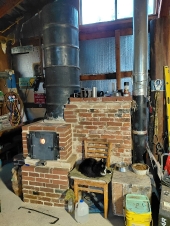I find the myriad of styles, types and sizes confusing.
I had a look at the site
https://batchrocket.eu/en/building#size and it came up with a need for 2.4Kw of heat with a 20 deg. C temp. difference.
So the formula it suggests for heater size is Q = G*V*DT with Q being the heat losses (W), G being the insulation factor, V the volume of the house (m3), and DT the required difference of temperature between the exterior and the interior (°C).
G is estimated in comparison to a set of classical values, listed below:
- 1.8 for an old, leaky, stone and clay mortar house (classical french farmhouses)
- 1.6 for a house in bricks, stones or breeze blocks without insulation
- 1.4 for a house insulated with 4 cm of polystyrene
- 1.2 for a house insulated with 10 cm of polystyrene
- 0.8 for a recent house with 37 cm thick insulating clay bricks for example
- 0.5 for a strawbale house for example
From its chart this may apply - 150 mm — 6.0 kg — 1.9 kW
The next step is to calculate the power of each batchrocket, as a function of its internal diameter (i.e. heat riser diameter). By default, the power of a heater is defined as the mean power it delivers on a 24h period with two fires a day. This power is calculated by considering an overall efficiency of 80%. With this efficiency, the combustion of a kilogram of air-dried wood will deliver 3.7 kWh of energy.
The bigger the internal diameter, the heavier the load of wood for each fire:
Internal diameter (mm) -- Wood load (kg) -- Mean power considering two fires a day (kW)
CHART
125 mm — 3.5 kg — 1.1 kW
140 mm — 4.9 kg — 1.5 kW
150 mm — 6.0 kg — 1.9 kW
175 mm — 9.5 kg — 2.9 kW
200 mm — 14.2 kg — 4.4 kW
230 mm — 21.6 kg — 6.7 kW
250 mm — 27.8 kg — 8.6 kW
From this chart it seems a 1.9 Kw system is needed at my place.
Is this the way others read it?









